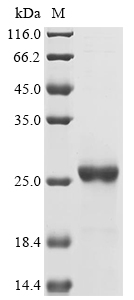This recombinant Tetracycline repressor protein class B (tetR) from Escherichia coli is expressed in an E. coli system, covering the full-length sequence from amino acids 1 to 207. The protein comes without tags, which should help maintain its native structure and function. Its purity exceeds 85%, as verified by SDS-PAGE analysis, making it appropriate for demanding research applications. The product is meant for research use only and isn't recommended for therapeutic or diagnostic purposes.
The Tetracycline repressor protein (tetR) appears to play a central role in how bacteria resist antibiotics by controlling tetracycline resistance gene expression. It's an essential component of the transposon Tn10 system, which seems to manage gene expression based on whether tetracycline is present. As a well-studied model system, tetR has become important for research into antibiotic resistance, gene regulation, and molecular biology more broadly.
Potential Applications
Note: The applications listed below are based on what we know about this protein's biological functions, published research, and experience from experts in the field. However, we haven't fully tested all of these applications ourselves yet. We'd recommend running some preliminary tests first to make sure they work for your specific research goals.
Based on the provided information, the recombinant E. coli tetR is expressed in its native E. coli system, which significantly increases the probability of proper folding and functionality. As a bacterial regulatory protein expressed in its homologous prokaryotic system, tetR has a high likelihood of correct folding since E. coli contains the necessary cellular machinery for its own proteins. The protein is full-length (1-207aa) with no fusion tags and >85% purity, which are favorable conditions for proper structure formation. However, since activity is unverified, the protein cannot be assumed to be bioactive without experimental validation of its DNA-binding capability and tetracycline-responsive regulatory function.
1. Protein-DNA Interaction Studies
This application is appropriate but requires activity validation first. While the tag-free nature eliminates potential tag interference, if tetR is misfolded or inactive, DNA-binding studies (EMSA, SPR) will yield invalid results. The protein must be confirmed to bind specifically to tet operator sequences and respond to tetracycline induction before meaningful interaction studies can be performed.
2. Antibody Development and Validation
This application is well-suited as the safest use case. The recombinant tetR can serve as an effective immunogen for generating antibodies against linear epitopes. The tag-free, full-length structure ensures authentic epitope presentation. Antibodies should be validated against native tetR from E. coli to confirm recognition of physiological conformations.
3. Protein Stability and Folding Analysis
This application is highly appropriate and should be prioritized for initial characterization. Biophysical techniques (circular dichroism, differential scanning calorimetry) can directly assess the protein's folding state and stability without requiring functional activity. The tag-free format ensures measurements reflect native protein behavior.
4. In Vitro Transcription Regulation Assays
This application is high-risk without functional validation. If tetR is improperly folded, transcription assays will not accurately reflect its repressor function. This application requires prior confirmation of both DNA-binding capability and tetracycline-responsive regulation using known operator sequences and induction conditions.
Final Recommendation & Action Plan
Given the homologous expression system and tag-free design, this tetR has high potential for proper folding. Recommended first steps: 1) Validate DNA-binding activity using EMSA with known tet operator sequences; 2) Test tetracycline responsiveness by measuring operator binding in presence/absence of inducer; 3) Perform biophysical characterization (CD spectroscopy, thermal shift) to confirm proper folding. Antibody development and stability studies can proceed immediately. Functional transcription assays should await confirmation of DNA-binding capability. Always include appropriate controls, such as known operator sequences and non-specific DNA in binding studies.






